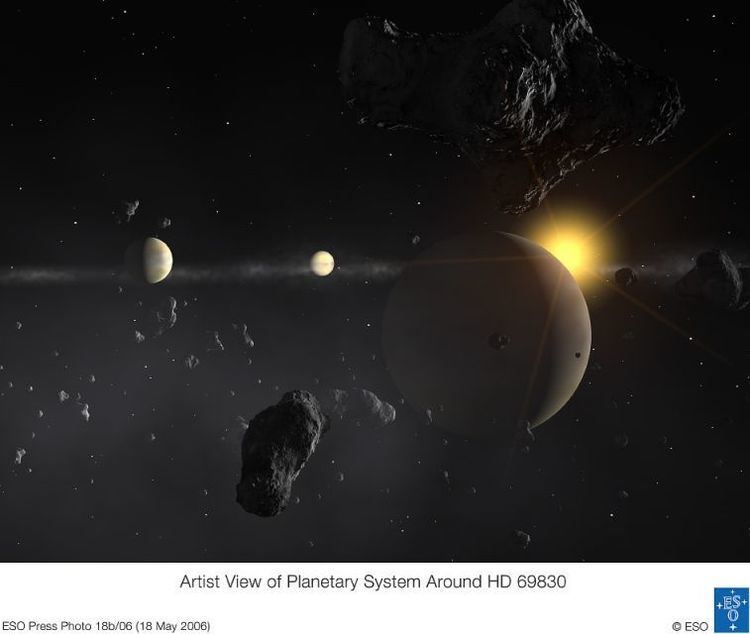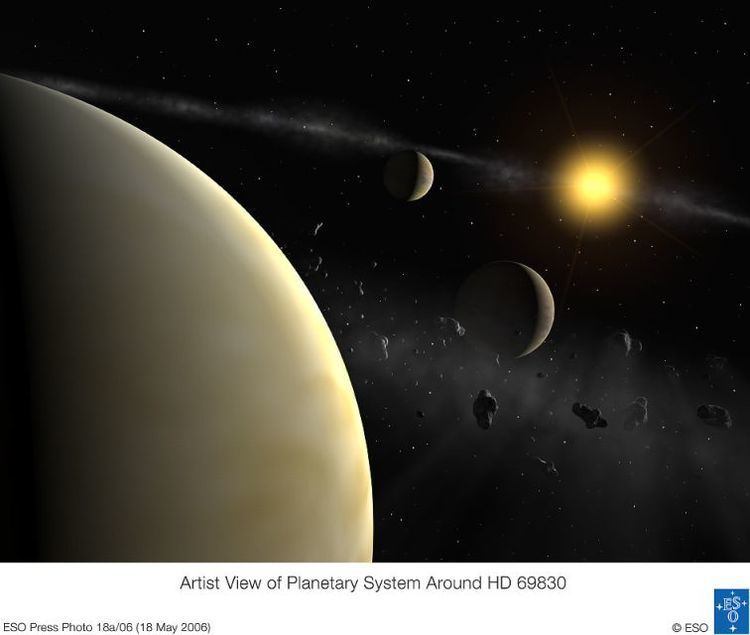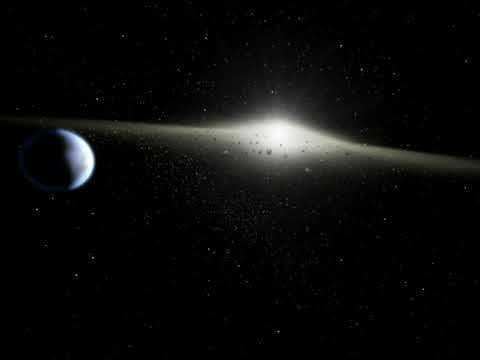ARICNS data | Magnitude 5.98 | |
 | ||
Similar HD 69830 d, HD 69830 b, HD 69830 c, 61 Virginis, HD 40307 | ||
Asteroid belt circling star hd 69830
HD 69830 (285 G. Puppis) is an yellow dwarf star approximately 41 light-years away in the constellation of Puppis. In 2005, the Spitzer Space Telescope discovered a debris disk orbiting the star. The disk contains substantially more dust than the Solar System's asteroid belt. As of 2006, it has been confirmed that three extrasolar planets with minimum masses comparable to Neptune orbit the star, located interior to the debris disk.
Contents

Distance and visibility
HD 69830 is a G-type main sequence star of the spectral type G8V. The star has a mass of about 86 percent the Sun, 90 percent of its radius, 62 percent of its luminosity, and 11 percent less iron abundance. Its age is about 10.6 ± 4 billion years. HD 69830 is located about 40.7 light-years from the Sun, lying in the northeastern part of the constellation of Puppis (the Poop Deck). The star can be found east of Sirius, southwest of Procyon, northeast of Delta Canis Majoris, and north of Zeta Puppis.
Planets

On May 17, 2006, a team of astronomers using the European Southern Observatory's (ESO) HARPS spectrograph on the 3.6-metre La Silla telescope in the Atacama desert, Chile, announced the discovery of three extrasolar planets orbiting the star. With minimum masses between 10 and 18 times that of the Earth, all three planets are presumed to be similar to the planets Neptune or Uranus. As of 2011, no planet with more than half the mass of Jupiter had been detected within three astronomical units of HD 69830.
The star rotates at an inclination of 13+27
−13 degrees relative to Earth. It has been assumed that the planets share that inclination. However b and c are "hot Neptunes", and outside this system several are now known to be oblique relative to the stellar axis.
The outermost planet discovered appears to be within the system's habitable zone, where liquid water would remain stable (more accurate data on the primary star's luminosity will be required to know for sure where the habitable zone is). HD 69830 is the first extrasolar planetary system around a Sun-like star without any known planets comparable to Jupiter or Saturn in mass.
Debris disk
In 2005, the Spitzer Space Telescope detected a debris disk in the HD 69830 system consistent with being produced by an asteroid belt twenty times more massive than that in our own system. The belt was originally thought to be located inside an orbit equivalent to that of Venus in the Solar System, which would place it between the orbits of the second and third planets. The disk contains sufficient quantities of dust that the nights on any nearby planets would be lit up by zodiacal light 1000 times brighter than that seen on Earth, easily outshining the Milky Way.
Further analysis of the spectrum of the dust revealed that it is composed of highly processed material, likely derived from a disrupted C-type asteroid of at least 30 km radius which contained many small olivine-rich (rocky) and once-wet grains which would not survive at close distances to the star. Instead, it seems more likely that the asteroid belt producing the dust is located outside the orbit of the outermost planet, around 1 AU from the star. This region contains the 2:1 and 5:2 mean motion resonances with HD 69830 d.
